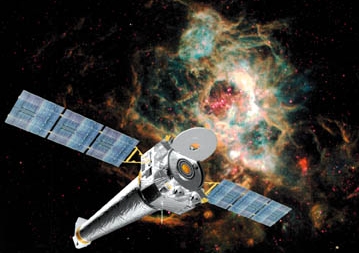| Chandra X-Ray Observatory | |||||
 |
|||||
|---|---|---|---|---|---|
| The third of NASA's Great Observatories for Space Astrophysics | |||||
| Chandra | Science | Spectrum | History | Resources | Great Observatories |
| Chandra X-Ray Observatory | |||||
 |
|||||
|---|---|---|---|---|---|
| The third of NASA's Great Observatories for Space Astrophysics | |||||
| Chandra | Science | Spectrum | History | Resources | Great Observatories |
The Chandra X-Ray Observatory is a space satellite, the third of NASA's Great Observatories for Space Astrophysics. The first two to be sent to Earth orbit were the Hubble Space Telescope and the Compton Gamma Ray Observatory. Chandra observes the Universe in the high-energy x-ray portion of the electromagnetic spectrum. That band is between the windows on the Universe opened by the Hubble and Compton telescopes.
During design and construction, Chandra was known as the Advanced X-Ray Astrophysics Facility (AXAF). It was renamed in 1998 in honor of the late Indian-American Nobel laureate astrophysicist Subrahmanyan Chandrasekhar.
Chandra gives astronomers a new view of some of the most violent and energetic activities in the Universe. Compared with the red-green-blue visible light we see, which carries an energy of about 2 electron-volts, Chandra sees energy ranging from 50 to 10,000 eV.
On July 23, 1999, the NASA space shuttle Columbia, flight STS-93, carried Chandra to a low Earth orbit from where Chandra used its own thrusters, plus an Inertial Upper Stage (IUS) two-stage solid-fuel rocket, to travel higher to an orbit ranging from 6,200 to 86,800 miles above the Earth's radiation belts. Those belts are a potential source of noise for Chandra's detectors. After it was positioned in space, Chandra was powered up, its eye door opened,and x-rays were focused onto the science instruments inside the telescope.
Chandra collected its first light on August 19, 1999. NASA marked the second anniversary of the first images from the Chandra X-ray Observatory by extending the project's mission from five years to ten years.
X-rays from astronomical bodies cannot be observed from ground level because the Earth's atmosphere blocks them. Only instruments beyond the atmosphere can measure the x-ray sky.
Chandra X-ray Observatory collected its first light on August 19, 1999. The X-ray image was the ten-lightyears-wide supernova remnant Cassiopeia A, which is 10,000 lightyears from Earth.
During its life in space, at times when it's in the dark, Chandra sees its own nightlight, a set of radioactive buttons inside the contamination door. The nightlight emits X-rays, which serve as calibration sources so the science team down on Earth can check up on the performance of Chandra's instruments.
Is Chandra the world's greatest observatory for x-ray astronomy? Well, you could read a newspaper from half a mile away or see a stop sign from 12 miles. That's the kind of strength packed into the world's most powerful X-ray telescope.
Chandra Science Spectrum History Resources
Hubble Compton SIRTF Great Observatories Telescopes Deep Space
Search STO About STO Questions Suggestions Feedback E-Mail
© 2002 Space Today Online E-mail